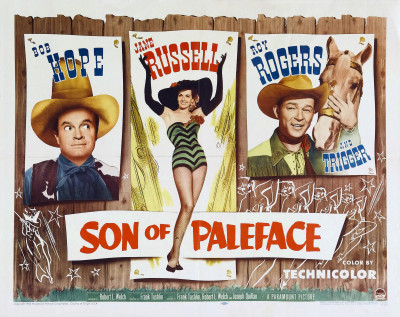| Reviews & Columns |
|
Reviews DVD TV on DVD Blu-ray 4K UHD International DVDs In Theaters Reviews by Studio Video Games Features Collector Series DVDs Easter Egg Database Interviews DVD Talk Radio Feature Articles Columns Anime Talk DVD Savant Horror DVDs The M.O.D. Squad Art House HD Talk Silent DVD
|
DVD Talk Forum |
|
|
| Resources |
|
DVD Price Search Customer Service #'s RCE Info Links |
|
Columns
|
|
|
Son of Paleface
Two factors raise Son of Paleface several notches above the average Bob Hope comedy. First, it was directed and co-written by Frank Tashlin, the nomadic cartoon shorts director, who left that field in 1946 to become a gag writer for many of the top comedians of the day. He took over the direction of Hope's The Lemon Drop Kid and, often incorporating cartoon-style sight gags into his work, peaked as a feature film director in the mid-1950s, notably with the films The Girl Can't Help It (1956) and Will Success Spoil Rock Hunter? (1957). He also directed many of Jerry Lewis's better films, including Artists and Models, Hollywood or Bust (both with Dean Martin, 1955 & '56), Rock-A-Bye Baby, and The Geisha Boy (both 1958).
The other, less acknowledged quality lifting up Son of Paleface is the addition of Roy Rogers and his faithful horse, Trigger (the "Smartest Horse in the Movies," as he was billed). Amazingly, up to then no one had ever thought to team one of the iconic B-Western cowboys with an A-list comedian before. At least not in this way. For instance, Dick Foran and Johnny Mack Brown co-starred with Abbott & Costello in 1942's Ride ‘Em Cowboy, but in that and other cases B-Western stars were merely along for the ride (‘em). For Son of Paleface, Hope is essentially tossed into a B-Western story with, in this case Roy Rogers and Trigger, appearing in exactly the kind of singing cowboy story they always did, albeit with a much higher budget and longer shooting schedule.
B-Western icons like Gene Autry and William "Hopalong Cassidy" Boyd almost never appeared in A-features, and never in this manner. In 1952 Roy Rogers was genuinely beloved by a generation of children, his admirers vesting expanding at the time as Roy had made his last B-Western, Pals of the Golden West, in 1951, the same year he launched his wildly popular (with kids) The Roy Rogers Show, which lasted six seasons and spawned scads of merchandising and fan clubs. Son of Paleface strikes a delicate balance in letting Roy be Roy, while at the same time gently poking fun at his clean-cut image.
A generation after the events of The Paleface, Peter "Junior" Potter (Hope), a new Harvard graduate, travels to the western town of Sawbuck Pass to claim his late father's fortune.
Meanwhile, government agent and singing cowboy Roy (Rogers) is investigating a series of daring stagecoach robberies committed by a gang lead by the mysterious "The Torch," actually saloon singer Mike Delroy (Jane Russell), who use the underpinnings of a covered bridge as their hideout.
Junior is in a jam when he discovers that his father's treasure chest is empty and the town is in an uproar, as Daddy died owing money to nearly everyone in town. Junior pretends to be overcome with all the gold his father supposedly left him, stalling for time. He soon sets his sights on Mike, unaware that she's also The Torch, while she pines away for Roy, unaware that he's hot on her trail.
The movie works best when it sticks to spoofing Western movie iconography, such as Roy's preference to the company of Trigger over buxom Mike, which baffles Junior. One justly famous scene (which my 10-year-old daughter loved) has Junior sharing a bed with Trigger, and the two fight over the covers, Trigger repeatedly pulling them back on (using his teeth) and Junior pulling ‘em off again. The gag is repeated itself at least ten times, but my daughter never tired of it.
One thing damaging the film a bit is that Hope's Junior jaded, over-indulged college grad becomes more than a bit grating. Early on, for instance, Roy and Mike sing "Buttons and Bows," the Oscar-winning song from The Paleface, only this time Junior constantly interrupts their performance with smarmy remarks. What might have worked with Hope cracking wise during a song performed by Bing Crosby and Dorothy Lamour doesn't work because the characters are different here.
Video & Audio
Son of Paleface was an early HD DVD title, and in that format, at that time, this Technicolor, 1.37:1 production looked great. Now, all these years later and apparently utilizing the same transfer, Son of Paleface still looks very good, if less scintillating than it did, HD transfer technology having substantially improved during the interim. The mono audio, DTS-HD Master Audio 2.0, is decent, though no subtitle options this time out.
Extra Features
Supplements include an audio commentary by Greg Ford and a reconstruction of The Lady Said No, a 1946 puppet short directed by Tashlin after he'd stopped directing cartoons but before becoming gag writer and feature film director.
Parting Thoughts
Entertaining for the entire family, Son of Paleface is Highly Recommended.
Stuart Galbraith IV is the Kyoto-based film historian largely absent from reviewing these days while he restores a 200-year-old Japanese farmhouse.
|
| Popular Reviews |
| Sponsored Links |
|
|
| Sponsored Links |
|
|
| Release List | Reviews | Shop | Newsletter | Forum | DVD Giveaways | Blu-Ray | Advertise |
|
Copyright 2024 DVDTalk.com All Rights Reserved. Legal Info, Privacy Policy, Terms of Use,
Manage Preferences,
Your Privacy Choices | |||||||














